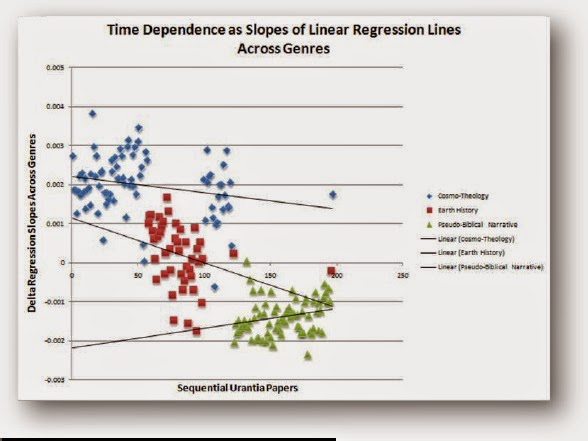Two of the studies on the Urantia Book are only easily available in summary form as published in newsletters and on the Urantia Book website. The third study examined the Urantia Book using the Delta method employed by Jockers and coworkers as part of their examination of the Book of Mormon, and was performed by a Latter-day Saint rather than a follower of Urantia.
Science, Anthropology and Archaeology in The Urantia Book, Part 3
by Dr. Ken Glasziou
Who Wrote the Urantia Papers?
One of the newsletters cited in the above article
Delta method paper by Christopher Smith
I'm just going to summarize what I see as the most telling points of "Who Wrote the Urantia Papers?"
- Analyses of non-contextual function words and their usage are able to distinguish among at least 5 narrators and potentially 9 with high degrees of certainty.
- None of the Urantia Papers are in the normal writing style of one proposed 20th century author.
- Writing sample sizes are mostly large enough to give statistical confidence as long as application of the statistical tests is deemed justified.
- Each of 8 authors with sufficient papers for testing was statistically identifiable.
- When tested against a few 20th century human authors, the styles of the Urantia Papers were matched mostly with control authors who were in no way connected with their production (Freud and Mr. Smith).
So multiple authors appears to be a distinct possibility at this point. But we need to remember two concerns identified in previous stylometric studies: 1. changes in genre can change word usage, and 2. authors' styles can change over time. The Urantia Papers cover three broad genres identified by Mr. Smith as Cosmo-Theology, Earth History, and Pseudo-Biblical Narrative. They were also produced over a matter of years, giving sufficient time for possible shifts in authorial style. So Mr. Smith divided the texts into the three genres and again plotted them by time of production. Look at what we see:
In each case the style within the genre is more uniform than the style between genres, and the style changes linearly with time. The conclusions strictly dictated by these data seem to be that function word stylometry reveals three genres, and doesn't lead to any strong conclusions regarding the number of authors within each genre. So from evidence of eight or more authors, we are reduced to evidence consistent with one single author changing his style over genres and time--both phenomena that we have seen before with Joanna Southcott and Sidney Rigdon.
It is possible that higher resolution methods, like non-contextual word pairings used by Hilton and his colleagues, or the combination of four types of stylometric features as used by Schaalje and Fields, would reveal multiple authorship in the Urantia Book, but I think some comparisons with the Book of Mormon can be usefully made even with these limited, non-peer reviewed results:
|
Could a Single Author Produce the
Variety of Stylometric Features?
|
||
|
Fooling Stylometric Measures |
Mormon Scripture |
Urantia Book |
|
6500 word reference samples |
Multiple 10000 word reference samples |
Multiple papers of at least 1000 words |
|
500 word samples for classification |
10000 word samples for classification |
At least 1000 words for classification 1000 is better than 500, but weaker than 10000 |
|
Simple, familiar topics |
Complex, unfamiliar topics. Joseph Smith is reported to have
told stories about some topics treated in the Book of Mormon, but
had not previously written anything of significant length. |
Complex topics of unknown familiarity. Saddtler was demonstrably well read and previously or simultaneously wrote on several topics related to the Urantia Book. |
|
Written in short times |
Written or dictated in short times. No time available for
significant, subconscious shifts in authorial style. |
Written in unknown amounts of time (possibly short), but over
many years, thus allowing for observed linear shifts in authorial
style. |
|
'Dumbed down' to obscure personal style |
Less rich vocabulary in Mormon scripture than in Joseph Smith's
personal papers. |
Styles changed to match genre, a conscious decision influencing
style available even to untrained authors. |
|
Distictive authorial style for imitation |
No historically verified texts being imitated |
Saddtler is known to have read
and possessed numerous texts on topics treated in the Urantia
Book, however the only clear imitation is the Bible, similar to
the Book of Mormon. |
|
Closed set of authors |
Open set of authors |
Varied. |
|
Adversarial authorship attack known |
No direct evidence of fraud |
No direct evidence of fraud |
|
Machine translation doesn't disguise style |
Claimed to be translations, suggesting authorial styles should
be preserved. |
Claimed to be revelations. We don't know what to expect stylometrically from revelations from different sources. |
|
Genre controlled |
Genre controlled for in some studies, revealing multiple
authorship. |
Genre controlled for in one study, consistent with single
authorship. |
That's it for now. Out of time.



Interesting stuff, Jonathan. Thanks.
ReplyDelete